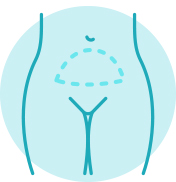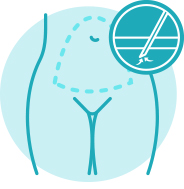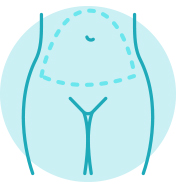An abdominoplasty or “tummy tuck” is a surgical procedure designed to trim excess skin on the abdomen, tighten abdominal muscles and remove excess fat. Dr Vlad Milovic, a specialist plastic surgeon, performs tummy tuck surgery on men and women using the latest techniques. View examples of our successful procedures in our Tummy Tuck Photo Gallery.
Quick Facts about Tummy Tuck Procedures
- Anaesthesia: General anaesthesia
- Inpatient/Outpatient: Typically inpatient
- Potential Benefits: Reworking and redraping of redundant skin and muscle in the abdominal region; removal of unwanted fat with liposuction
- Potential Side Effects: Swelling, bruising and various additional risks associated with all surgical procedures (see below)
- Recovery Time: Approximately three months maximum
Risks of Surgery
All surgical procedures carry risks and the potential for complications. While Dr Milovic is extensively trained and experienced with a comprehensive array of plastic surgery procedures and utilises advanced techniques to help mitigate those risks, patients considering treatment should always be fully aware of them beforehand. Dr Milovic will go over all risks and potential complications associated with the procedure during the initial consultation, and we are happy to address any questions or concerns you may have.
Risks of this procedure include, but are not limited to:
- Infection
- Scarring
- Excessive bleeding
- Pain/discomfort
- Nerve damage
- Bruising
- Swelling
- Complications relating to anaesthesia
- Seroma (a growth/lump near the surgery site that may become infectious)
- Unsatisfactory cosmetic results
- Death
- Poor wound healing
- Potential for an additional surgery
- Blood clots
- A “looseness” of skin that can be recurrent
- Skin discolouration
- Asymmetrical contour results
- Skin loss
Is A Tummy Tuck Right for Me?
Abdominoplasty or tummy tuck surgery is a highly individualised procedure, and as such, may not be suitable for everyone. It is a very personal decision and you should have realistic goals and expectations before undergoing surgery.
At your first consultation, Dr Milovic will assess your general health, examine your abdomen, discuss your concerns, evaluate how an abdominoplasty can improve your appearance and help determine whether the procedure is right for you. If you are planning to have more children, you should discuss this with Dr Milovic at your consultation; however, it is usually advisable to wait until after you have completed your family to have this procedure.
A tummy tuck is not suitable for people who cannot have anaesthetic, are prone to bleeding, have poor healing ability or are too high of a risk for surgical complications.
A tummy tuck is not a substitute for weight loss nor an appropriate exercise program. You may be asked to consider delaying the procedure if you are still in the process of losing weight or if you are planning on having more children.
A tummy tuck may be a good option for you if you:
- Desire improvement of skin and muscle laxity in the abdominal area
- Are physically healthy and at a stable weight
- Have realistic expectations
- Are a non-smoker or have stopped smoking, or will stop smoking during the surgery and entire recovery period
Tummy Tuck Surgery and Liposuction
Tummy tuck surgery and liposuction differ in both procedural details and goals, with the latter more specifically targeting localised buildups of fat. With this in mind, liposuction is frequently used as part of the abdominoplasty procedure and plays a vital role in certain tummy tuck techniques. If it aligns with your main concerns, Dr Milovic may deem you a candidate for abdominoplasty with liposuction. This method employs a small hollow tube called a “cannula,” which is into the treatment area to suction out excess fat. When performed by an experienced surgeon, liposuction as a part of abdominoplasty can reshape and contour the treatment areas, and in effect, “sculpt” the body shape.
What Are My Tummy Tuck Options?
There are a number of tummy tuck options available that include the mini tummy tuck and Brazilian tummy tuck (waist recontouring). Dr Milovic will discuss these options with you at your first consultation.
Mini Tummy Tuck

This procedure is designed to address skin laxity and excess tissue below the belly button. The abdominal muscles usually are not tightened in this approach, so it is suitable for only very specific patients with needs focused primarily within the lower waistline.
Brazilian Tummy Tuck

Waist recontouring, also known as a Brazilian tummy tuck, is an innovative technique pioneered by Dr Milovic which is designed to enhance the hourglass figure in women and the sculpted V-shape in men by using updated abdominoplasty methods. This procedure can be performed in combination with a traditional tummy tuck approach or apronectomy in suitable cases.
Full Tummy Tuck

To address excess skin, muscle laxity and unwanted fatty tissue above and below the belly button, a full tummy tuck is often recommended. In this procedure, an incision stretching from hip to hip is made low on the abdomen, in a location that should be hidden under swimwear and underwear. Dr Milovic can then tighten the underlying muscles and trim excess skin.
Liposuction can be included in any of the above techniques to effectively remove fat build-up in these areas. The SAL method, a traditional liposuction technique, involves the use of a small cannula. The plastic surgeon carefully pushes and pulls the cannula—which is attached to a vacuum device—in a forward-and-backward motion through the fat layer, breaking up the fat cells and drawing them out of the body by suction.
How Is the Tummy Tuck Procedure Performed?
You will have at least two consultations with Dr Milovic before surgery, and he can answer specific questions about what to expect after your operation. Be sure to ask questions to ensure that you go into this procedure feeling comfortable with realistic expectations. Dr Milovic will give you specific instructions on post-operative care before your surgery. These instructions may include:
- How to care for the surgical site and drains
- How to apply medications
- Specific concerns to look for at the surgical site or in your general health
- When to follow up with your surgeon
Dr Milovic will only perform your abdominoplasty surgery in accredited operating facilities. Abdominoplasty is performed under general anaesthesia and can require a one-to-two-night hospital stay. The procedure can take between two to three hours to complete, depending on which surgical technique is used and the complexity of your case.
During the operation, and depending on the details of your treatment plan, Dr Milovic will create an incision along the lower abdomen to access the foundational structures. Once the muscles have been tightened (creating a corset-like shape that holds in and flattens the waistline), the belly button will be relocated, fat removed via liposuction and excess skin trimmed away. The incision will be closed up and bandages applied.
What Can I Expect During Recovery from Abdominoplasty?
Recovery time will vary from patient to patient and will also depend on the extent of the surgery. Expect at least two weeks off work to allow for complete rest and another one week for the majority of visible swelling and bruising to disappear. Light exercise may be resumed within two to three days, but strenuous exercise should be avoided for at least two to three months. You will be given post-surgery instructions to follow and if you have any questions, please speak to Dr Milovic.
Following your surgery, dressings or bandages may be applied to your incisions. You may be wrapped in an elastic bandage or a compression garment to minimise swelling and to support your abdomen as it heals. A small, thin tube may also be temporarily placed under the skin to drain any excess blood or fluid that may collect.
Will I Have Visible Tummy Tuck Scars?
Initially after abdominoplasty, scars typically appear reddish in colour. They should eventually fade to a light pink. Abdominoplasty incisions are generally made on the bikini line, though this can vary.
If scarring is a particular concern for you, Dr Milovic can recommend treatments (e.g. silicone gel and laser therapy) to potentially expedite scar healing.
How Long Does a Tummy Tuck Last?
Abdominoplasty surgery is designed to produce permanent effects; however, your lifestyle and habits can modify your results, as can the natural process of ageing. Pregnancy and childbirth, as well as significant weight gain, can alter your abdominal contours, which is why we recommend maintaining a healthy weight and waiting until you have finished building your family to have a tummy tuck. Abdominoplasty should not inhibit your ability to get pregnant, so should you decide to have another child down the line, this procedure should have no impact on your fertility.
Would you like to learn more about tummy tuck surgery and its benefits? Contact our practice to find out if this procedure can aid you in achieving your goals.
Tummy Tuck Before & After Pictures
For a preview of Dr Milovic’s tummy tuck results, we invite you to explore the gallery below. If you wish, we can provide additional patient before-and-after photos during your initial consultation.
Can I Get a Non-Surgical Tummy Tuck?
While no existing non-surgical procedure can sculpt the abdomen to the same extent as abdominoplasty, certain treatments can achieve abdominal rejuvenation effects on a smaller scale. For instance, the innovative Venus Legacy™ device is designed to tighten the skin in the midsection in a relatively quick, minimally invasive manner, though it cannot deliver the same long-lasting and significant tightening effects as can abdominoplasty.
If you are unsure whether tummy tuck surgery, a non-surgical treatment or an alternative procedure is best to meet your needs, Dr Milovic will gladly help you decide after an initial examination.
Additional Frequently Asked Questions About Abdominoplasty
How much weight can I lose with a tummy tuck?
While a tummy tuck can significantly alter the appearance of the abdomen, it is not a weight loss procedure and should not be considered as such. Rather, the ideal tummy tuck candidate is relatively close to the average healthy weight for their body type and plans to follow a well-balanced diet and exercise regimen following the procedure.
Can a tummy tuck combat stretch marks?
A tummy tuck cannot directly target or remove stretch marks, as the procedure was specifically designed to tighten abdominal muscles and remove excess skin and fat. That being said, stretch marks located on excised skin can sometimes be reduced.
Can a tummy tuck address cellulite?
Abdominoplasty is generally not able to lessen the appearance of cellulite. This is because cellulite is caused by fat deposits pushing through the connective tissue beneath the skin, and is not necessarily related to the amount of excess skin or fat.
Does the Tummy Tuck® Belt work?
In recent years, a device known as the “Tummy Tuck Belt” has circulated the internet. The Tummy Tuck Belt, a corset-like device that is placed on the abdomen, has been said to burn away fat and create a slimmer, more toned midsection almost instantaneously. Obviously, this option is not capable of providing the same results as a tummy tuck since it does not remove excess skin or surgically repair/tighten abdominal muscles. Dr Milovic advises patients to use great caution when considering options other than an actual tummy tuck that claim to produce immediate satisfaction and similar results, as virtually no such procedure exists.
How long does swelling last after tummy tuck surgery?
Swelling can be expected for at least the first few weeks following your surgery. While this is a common abdominoplasty side effect and should not generally be cause for alarm, certain healthy habits, such as drinking plenty of water and limiting your salt intake, can ease residual swelling. It is also imperative that you adhere to your aftercare instructions for as quick and safe a recovery as possible.
How long will I have to wear drains after tummy tuck surgery?
Post-surgical tummy tuck drains can reduce the risk of complications like seromas (fluid accumulation) and aid in the healing process. The duration for which you will need to wear these drains can vary significantly depending on the extent of the surgery, your body’s healing response and other factors. Dr Milovic will provide detailed instructions for how to manage your drains, and welcomes any questions you may have about this part of the procedure.
Can you get pregnant after tummy tuck surgery?
Although tummy tuck surgery should not impede your ability to have children (i.e. interfere with fertility), Dr Milovic generally recommends that patients finish building their families before they consider tummy tuck surgery. This is because pregnancy and childbirth can cause the muscles Swelling can be expected for at least the first few weeks following your surgery. While this is a common abdominoplasty side effect and should not generally be cause for alarm, certain healthy habits, such as drinking plenty of water and limiting your salt intake, can ease residual swelling. It is also imperative that you adhere to your aftercare instructions.

